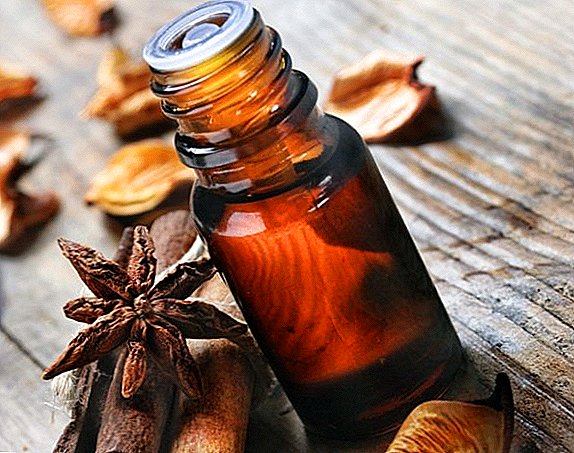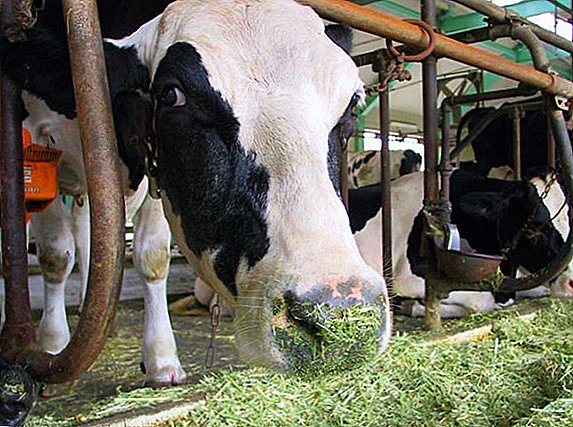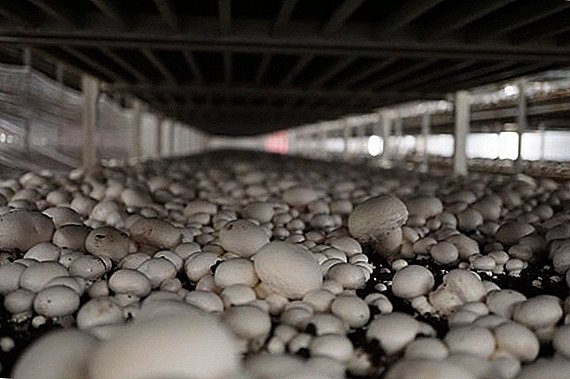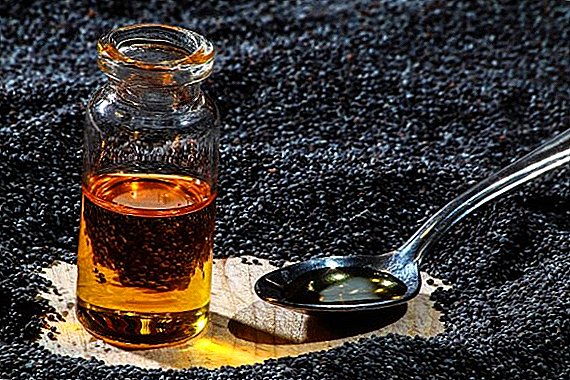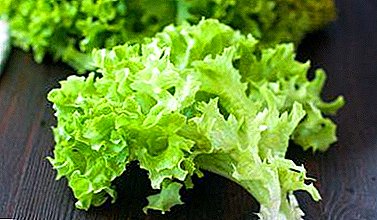
Lettuce adds bright colors to our food. It is used with pleasure for salads and sandwiches, for vitamin cocktails.
But in addition to aesthetic pleasure, it brings considerable benefits to our body, as it has many useful properties.
In our article we will tell in detail about the beneficial properties of this plant, to whom it is recommended to eat it, and also to warn about the possible harm of lettuce to human health.
Plant benefits
With greater physical exertion contributes to a more rapid recovery of the body. When dealing with overweight lettuce must be included in the diet, because it improves lipid metabolism and promotes weight loss.
We offer to watch a video about the beneficial properties of lettuce:
Minerals and Amino Acids
 Lettuce is rich in micro and macro elements necessary for normal functioning of the body. So per 100 grams of lettuce comes:
Lettuce is rich in micro and macro elements necessary for normal functioning of the body. So per 100 grams of lettuce comes:
- macronutrients: Ca — 36 mg; Mg - 13 mg; Na - 28 mg; K -194 mg; F - 29 mg;
- trace elements: Fe -0.9 mg; Zn- 0.2 mg; Cu - 30 µg; Mn - 0.25 mg; Se-0,6 mcg.
Salad contains more than twenty amino acids necessary for a person to produce protein and enzymes; maintain a stable psychological state. Amino acids increase the quality of sleep and sexual activity, promote wound healing and muscle recovery, make hair and skin beautiful.
There are BCAA amino acids in a lettuce - a complex of three essential amino acids leucine (0.079 g), isoleucine (0.084 g) and valine (0.070 g) that are not produced by our body and can only be obtained from food.
With this plant, a person receives glycine (0.056 g), methionine (0.015 g) and arginine (0.07 g), of which the body produces keratin. This substance increases the endurance of a person and quickly restores muscles after physical exertion, which is especially important for athletes.
Also 100 g of lettuce also contains the following amino acids:
- Tryptophan - 0.01 g (1.1% as a percentage of the daily norm).
- Threonine - 0.06 g (2.5%).
- Lysine - 0.084 g (2.0%).
- Cystine - 0.0159 g (0.9%).
- Phenylalanine - 0.055 g (1.3%).
- Tyrosine - 0.032 g (0.7%).
- Histidine 0.022 g (1.0%).
- Alanine - 0.055 g (0.8%).
- Asparagine - 0.142 g (1.2%).
- Glutamine - 0.182 g (1.3%).
- Proline - 0.048 g (1.1%).
- Serine - 0.04 g (0.5%).
Vitamins
In addition to minerals and amino acids The lettuce contains almost all the vitamins necessary for the body. Per 100 g of salad:
 Vitamin A (Retinol) - 370 mcg. Strengthens growth and development. It is a powerful antioxidant.
Vitamin A (Retinol) - 370 mcg. Strengthens growth and development. It is a powerful antioxidant.- Vitamin B1 (thiamine) - 0.07 mg. Indispensable for the full development, to ensure the normal functioning of the cardiovascular, digestive and nervous systems.
- Vitamin B2 (riboflavin) - 0.08 mg. Its wealth in the body ensures the health of hair, skin and nails, the normal operation of the thyroid gland.
- Vitamin B3 (nicotinic acid) - 0.135 mg. This vitamin is involved in the formation of enzymes and lipid metabolism.
- Vitamin B4 (Choline) - 13.5 mg. It helps to improve memory and strengthen the nervous system.
- Vitamin B6 (pyridoxine) - 0.1 mg. Required for the construction of hemoglobin, the synthesis of adrenaline, serotonin, dopamine, histamine. That is, it supports hormonal balance.
- Vitamin B9 (folic) - 38 mcg. Participates in the construction and operation of new cells.
- Vitamin E (tocopherols) - 0.25 mg. Slows down the aging of the body. People call it the beauty and youth vitamin. Increases the tone and elasticity of muscle tissue, promotes skin regeneration.
- Vitamin C (ascorbic acid) - 10-18 mg. Strengthens the immune system, is necessary for bone tissue, the absorption of iron.
- Vitamin K (phylloquinone) - 125-170 mcg. Required for metabolic processes in bone and connective tissues, for normal kidney function. Provides absorption of calcium and vitamin D.
Calorie content
Nutritional value of 100 g of lettuce is:
- caloric content - 15 kcal;
- proteins - 1.36 g (2% of the daily requirement);
- Fat: 0.15 g;
- carbohydrates - 1.49 g (1% of the daily requirement).
Who is recommended to eat?
- Lettuce is useful for both adults and children. Eating replenishes the supply of vitamins, minerals and amino acids necessary for health. For people who care about their health, it is necessary to include this plant in the menu: it is low-calorie, improves intestinal motility, replaces artificial food supplements and vitamins, helps maintain normal weight.
 For those expecting the birth of a baby mom, lettuce, rich in folic acid and iodine, is necessary for the normal development of the child. The use of lettuce restores immunity and accelerates recovery from tuberculosis, infectious diseases, shortens the rehabilitation period.
For those expecting the birth of a baby mom, lettuce, rich in folic acid and iodine, is necessary for the normal development of the child. The use of lettuce restores immunity and accelerates recovery from tuberculosis, infectious diseases, shortens the rehabilitation period.- The juice of the plant helps in the violation of the digestive system, with diseases such as atherosclerosis, hypertension, has a diuretic effect.
- Infusion of crushed lettuce leaves is used to treat scurvy, chronic gastritis, and liver. The high content of micro and macro elements reduces blood sugar.
- From the seeds of lettuce by the method of cold-pressed oil is prepared, which has healing properties. The oil is used as a sedative against depression, insomnia, nerve inflammation; to restore the liver, to treat the stomach. The use of oil gives the skin a tone, improves its condition, accelerates hair growth and strengthens its roots. As an external agent, the oil is used for massage, as well as for nourishing the skin.
Possible harm to health
Despite the undoubted benefits of lettuce for a person, in some cases, its use can be harmful to health. The presence of oxalic acid in a salad can provoke an exacerbation of chronic diseases.
Contraindications
Contraindications for use in eating lettuce are intestinal upset, colitis and entericolitis, gout and urolithiasis. The use of oil is not recommended for bronchial asthma.
When is undesirable?
In a small amount with caution should be used with high acidity, gastric ulcer and duodenal ulcer, gallstone disease.
In which cases it is absolutely impossible?
It is strictly not recommended to eat lettuce when:
- gout;
- enterocolitis;
- acute colitis
- urolithiasis in the acute stage.
Side effects
A side effect is possible only with the use of lettuce, if there are contraindications, as well as use in unlimited quantities. After all, some people, having learned about the benefits of a product, rush to extremes and begin to use it without measure. Follow a reasonable approach when compiling your menu and product selection.
How and in what quantities to use?
 Having dealt with the health benefits of lettuce, you can proceed to the recommendations on the use of this plant. For the preparation of salads, leaves are better shredded avoiding metal interactions.
Having dealt with the health benefits of lettuce, you can proceed to the recommendations on the use of this plant. For the preparation of salads, leaves are better shredded avoiding metal interactions.
Dishes better to use glass or ceramic. It is not recommended to keep lettuce for a long time, and to use cooked dishes immediately. The high water content in the leaves leads to a rapid loss of the appearance of the product.
For children
In the children's menu, the salad can be entered from one and a half years. Given the soothing effect of the lettuce, promotes good sleep, active kids can give it to dinner. Until the age of twelve, children have a daily allowance of salad - 50 grams.
For adults
For adults, the recommended daily intake is 100 grams. How to determine the amount when it is impossible to weigh the salad? This can be done with the help of glass. The norm for adults is two glasses, for children, respectively - one.
Recipes
From cough
- For cooking means you need 20 grams of lettuce (1/2 cup).
- Leaves need to chop hands.
- Pour one glass of boiling water.
- Insist two hours.
- After this strain the infusion.
You need to consume 50 ml of the resulting liquid three to four times a day.
Mask for the face
Masks for the face of lettuce give faded skin tone, they help to fight with oily shine, with inflammations.
- To prepare the mask will need 2 tablespoons of salad.
- 2 tablespoons sour cream.
- 1/2 tsp olive oil.
Cooking:
- lettuce leaves to obtain a homogeneous mass chop in a mortar;
- add sour cream and butter;
- mix everything thoroughly;
- apply on cleansed face for 20 minutes;
- then rinse with warm water.
Tonic composition
 Folk healers recommend an infusion of lettuce with high mental stress, stress, depression and sleep disorders. Infusion helps to restore the nervous system.
Folk healers recommend an infusion of lettuce with high mental stress, stress, depression and sleep disorders. Infusion helps to restore the nervous system.
For the preparation of infusion will need 20 grams of leaves and 200 grams of water.
- Grind the leaves in a mortar.
- Pour boiling water.
- Insist half an hour.
- Then strain.
Drink 100 ml for an hour before bedtime. For calming the nervous system, you can use lettuce oil inside: one hour before bedtime, drink 2 tablespoons and one tablespoon before bedtime.
To improve lactation
To improve lactation, you can prepare the following infusion: 20 grams of lettuce seeds pour two cups of boiling water, leave for two hours, drain. Drink 30 ml twice a day.
Lettuce, of course, is a very useful product. The use of this plant in food replenishes our body with nutrients and improves health. But this must be done taking into account the characteristics of your body and observing the measure.


 Vitamin A (Retinol) - 370 mcg. Strengthens growth and development. It is a powerful antioxidant.
Vitamin A (Retinol) - 370 mcg. Strengthens growth and development. It is a powerful antioxidant. For those expecting the birth of a baby mom, lettuce, rich in folic acid and iodine, is necessary for the normal development of the child. The use of lettuce restores immunity and accelerates recovery from tuberculosis, infectious diseases, shortens the rehabilitation period.
For those expecting the birth of a baby mom, lettuce, rich in folic acid and iodine, is necessary for the normal development of the child. The use of lettuce restores immunity and accelerates recovery from tuberculosis, infectious diseases, shortens the rehabilitation period.



